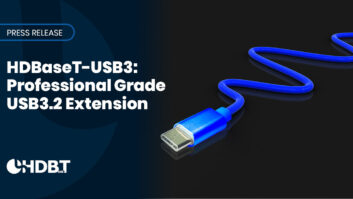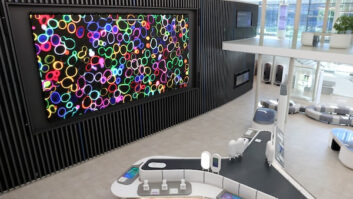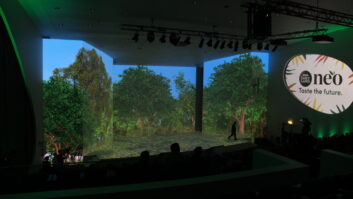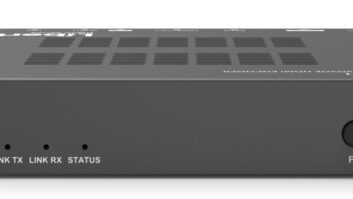As difficult as it may be to believe, it won’t be that long until HDBaseT marks its 15th anniversary. It was in June 2010 that the first version of the distribution standard, HDBaseT 1.0, was announced – the same month that supporting organisation HDBaseT Alliance was incorporated by Samsung, Sony Pictures Entertainment, LG Electronics and Valens Semiconductor.
All these years – and several iterations of the standard – later, HDBaseT continues to be a leading force in long-range multimedia distribution, facilitating the extension of signal up to 100m (328ft) over standard Cat5 or Cat6 cable.
Whilst the distance limitations have been challenged by subsequent (AV over IP) technologies, HDBaseT has continued to retain a strong market presence – not least in the current UHD era when its ability to support uncompressed, low latency 4K has resonated with customers in sectors incorporating corporate and education.
 The latest version, 3.0, was announced in 2019, and described as the “only solution in the market that enables long-reach distribution of uncompressed HDMI 2.0 4K@60 4:4:4 (18Gbps), while guaranteeing a plug-and-play, future-proof and interoperable network.” Fully backward-compatible with previous HDBaseT specifications, HDBaseT Spec 3.0 devices integrate Valens’ VS3000 Stello chipset.
The latest version, 3.0, was announced in 2019, and described as the “only solution in the market that enables long-reach distribution of uncompressed HDMI 2.0 4K@60 4:4:4 (18Gbps), while guaranteeing a plug-and-play, future-proof and interoperable network.” Fully backward-compatible with previous HDBaseT specifications, HDBaseT Spec 3.0 devices integrate Valens’ VS3000 Stello chipset.
In order to explore the technology’s ongoing appeal, Installation caught up with the HDBaseT Alliance as well as a trio of vendors (Blustream, Matrox and Kramer) who continue to develop new HDBaseT-oriented solutions. It is clear from their comments that they expect the technology to have a long future ahead of it, especially for applications where cost-efficiency, uncompressed signal delivery, and the avoidance of over-complexity are at the top of the priority list.
STRONG SHOWING
Effi Goldstein, who succeeded Tzahi Madgar as president of the HDBaseT Alliance in May 2023, points to the technology’s recent strong showing at InfoComm 2023: “We had a very busy line-up of exhibits and live demonstrations presented by HDBaseT Alliance members, including the largest-ever assembled collection of HDBaseT 3.0-supported devices. All of this underlines the fact that demand for HDBaseT 3.0 products – and their ability to extend fully uncompressed 4K@60Hz 4:4:4, along with USB 2.0, Gigabit Ethernet, power, and controls up to 100m over a single Category cable – is continuing to rise.”
Based in Melbourne, Australia, distribution solutions specialist Blustream has a long history of developing products that are compliant with the HDBaseT standard. Most recently, this roadmap has yielded several solutions supporting the latest 3.0 iteration, including the HEX18G-KIT advanced HDBaseT extender kit. For the first time, noted the company, the solution meant that AV integrators could deliver all 4K Dynamic HDR formats, including Dolby Vision, over lengths of up to 100m via HDBaseT.
“We have been on this path of developing HDBaseT products for a long time now,” confirms Jason Fitzgerald, product manager – AV solutions at Blustream. “The [latest solutions for HDBaseT 3.0] have really appealed to commercial and residential applications, where there is an overriding requirement to go P2P. Corporate environments and government command & control facilities would be good examples.”
As well as its ability to support 4K and HDR – whose usage beyond broadcast, its earliest adopter, is now growing steadily – Fitzgerald highlights HDBaseT’s avoidance of complexity. By contrast, he says, “video over IP is more complicated from an installation standpoint. Lots of companies are making it easier to integrate, but in the communications realms where you might have multiple switches, interacting with the IT department can sometimes prove to be a complex process. And if you don’t have a good deal of networking background, it can become a challenge.”
Hence the enduring view of HDBaseT as an easy-to-deploy technology that circumvents many of the installation and network maintenance issues that can occur with IP-based technologies to have emerged in subsequent years.
 Rob Moodey, who is manager strategic partnerships at video hardware and software solutions company Matrox, has another angle on HDBaseT’s market context with regard to IP. “I’d say we first really became aware of [HDBaseT] when we started on our AV over IP journey about 7 or 8 years ago,” he recalls. “One reason for this is that HDBaseT’s role as a P2P extension could be seen as a competitor to AV over IP in a particular range environment. But it was when the latest version, 3.0, came out that [everything shifted for us]. It coincided with our development of a new series of products, ConvertIP, that totally changed our relationship with [HDBaseT].
Rob Moodey, who is manager strategic partnerships at video hardware and software solutions company Matrox, has another angle on HDBaseT’s market context with regard to IP. “I’d say we first really became aware of [HDBaseT] when we started on our AV over IP journey about 7 or 8 years ago,” he recalls. “One reason for this is that HDBaseT’s role as a P2P extension could be seen as a competitor to AV over IP in a particular range environment. But it was when the latest version, 3.0, came out that [everything shifted for us]. It coincided with our development of a new series of products, ConvertIP, that totally changed our relationship with [HDBaseT].
Comprising a series of IPMX-ready encoders and decoders “designed for maximum flexibility, scalability and interoperability”, ConvertIP provides multiple input/output connectivity options for converting SMPTE ST 2110 IP signals between HDMI, HDBaseT or SDI. It also supports compressed and uncompressed 4K over IP signal transmission, rendering it suitable for underpinning a variety of workflows.
In terms of HDBaseT, the notable aspect, says Moodey, is that “it enables the HDBaseT protocol to get onto a regular LAN; [the inability to do so previously would], I think, have been highlighted as one of the weaknesses of the technology. [Other issues] would have been that you were limited to 100m with Cat cable, and that if it needed to be other than P2P there would be a requirement to put in a dedicated switch. By being able to put it on the network with the ConvertIP family – and specifically the SRST [transmitter/receiver] – addressed all of those issues with a single stroke, which I think the HDBaseT world was rather pleased about.”
NEW ENHANCEMENTS
At the same time, adds Moodey, HDBaseT 3.0 was also emerging into the industry, bringing with it a number of enhancements such as “uncompressed 4K60, and that would have challenged the existing methodology very well. [Previously] to do the 100m you would have had to have exactly the right cable, but if you can do the distance over the network you can take all the worries about the cable away. If you have 1GB network and it does 10GB, that’s that; same with 10GB and so on. So it gave a bridge for HDBaseT into all [of those network environments].”
 Meanwhile, it is clear he believes that the uncompressed distribution capabilities of HDBaseT are very resonant now in pro AV. “One of the things that I think has got lost sometimes in AV is that HDBaseT is an uncompressed story; that was one of its big deliverables,” he says. “But it was sometimes seen as just moving HDMI from A to B, and that sort of missed the fact it was moving it uncompressed. [Moreover] uncompressed is not just a broadcast story; it is in the sense of a 25GB network for 4K60, but all sorts of other things can be moved uncompressed at the lower bandwidths so long as you can get onto the network.”
Meanwhile, it is clear he believes that the uncompressed distribution capabilities of HDBaseT are very resonant now in pro AV. “One of the things that I think has got lost sometimes in AV is that HDBaseT is an uncompressed story; that was one of its big deliverables,” he says. “But it was sometimes seen as just moving HDMI from A to B, and that sort of missed the fact it was moving it uncompressed. [Moreover] uncompressed is not just a broadcast story; it is in the sense of a 25GB network for 4K60, but all sorts of other things can be moved uncompressed at the lower bandwidths so long as you can get onto the network.”
Networking technology specialist Kramer was one of the first big AV-oriented companies to start utilising HDBaseT. Eli Ofek, product director at Kramer, recalls: “Since the early days of HDBaseT 1.0, Kramer was one of the early adopters of the technology – the extra value and the market traction were the motivation and business justification for us. Kramer is using HDBaseT in all three product generations and categories. Starting with Matrix switches (fixed, all-in-one or modular), Extenders, presentation switchers and DAs, HDBaseT is an important part of Kramer’s offering for more than 12 years now.”
EXTRA RANGE
In terms of its primary strengths for pro AV, Ofek cites “ease of use and the extra range” it provides, adding: “The ability to carry all kind of signals together on category cable for 100m is the key. Full resolution 4K video, together with multi-channel audio, controls, USB, power and Ethernet enable [users ] to simplify installations and reduce costs dramatically. Installers like it very much and, in many cases, HDBaseT is a prerequisite/must-have in tenders.”
The rise of UHD across pro AV applications looks certain to be a factor in its continued popularity. Uncompressed 4K, observes Ofek, is “the ultimate most common request in small-to-medium room size installation. Uncompressed video means top quality of AV, with no processing or delay at all. Moreover, uncompressed HDBaseT connection does not need any software configuration or special IT involvement; it is similar to HDMI or USB cable connection. Anything else [can be] considered as a compromise; any type of compression adds delay and quality issues. In an ideal world we prefer to carry the original uncompressed signal all the way from source to sink.”
GREAT FUTURE
In closing, the vendors were asked to consider how they envisage HDBaseT evolving in future. For Kramer, the next UHD format is looming on the horizon: “Obviously, 8K is on our wish list, but not only that; USB-C (USB3.0 1st and 2nd generation together with 1Gb ETH, power and MST) is somehow even more important because any new device comes today with a USB-C port. We see it as a strategic move that will take effect very quickly.”
Moodey also urges a continued awareness of changing expectations around video in determining the future course of the technology. “The industry is evolving into greater resolutions, frame-rates and bit-depths, and all of those are finding their way, application by application, into our industry. So I think that HDBaseT should have its radar pointed at that in terms of what to do next.” Assuming all of that takes place, it’s evident that “there is a great future for HDBaseT”.
Fitzgerald, too, strikes a firmly upbeat tone. He says that whilst “we will see some more parity with video over IP” solutions being adopted, there continues to be a “huge amount of HDBaseT in use. It still sees a large adoption as a P2P extension, and that will continue, but it’s also not sitting on its laurels; it’s continuing to innovate, as we can see with 3.0. It remains a very cost-effective technology as well. So yes, it clearly has a good future ahead.”







